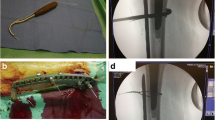Abstract
Objective
Stable fixation of periprosthetic or periimplant fractures with an angular stable plate and early weight bearing as tolerated.
Indications
Periprosthetic femur fractures around the hip, Vancouver type B1 or C. Periprosthetic femur and tibia fractures around the knee. Periprosthetic fractures of the humerus. Periimplant fractures after intramedullary nailing.
Contraindications
Loosening of prosthesis. Local infection. Osteitis.
Surgical technique
Preoperative planning is recommended. After minimally invasive fracture reduction and preliminary fixation, submuscular insertion of a large fragment femoral titanium plate or a distal femur plate. The plate is fixed with locking head screws and/or regular cortical screws where possible. If stability is insufficient, one or two locking attachment plates (LAP) are mounted to the femoral plate around the stem of the prosthesis. After fixing the LAP to one of the locking holes of the femoral plate, 3.5 mm screws are used to connect the LAP to the cortical bone and/or cement mantle of the prosthesis.
Postoperative management
Weight bearing as tolerated starting on postoperative day 1 is suggested under supervision of a physiotherapist.
Results
In 6 patients with periprosthetic fractures and 2 patients with periimplant fractures, no surgical complications (e.g., wound infection or bleeding) were observed. The mean time to bony union was 14 weeks. No implant loosening of the locking attachment plate was observed. At the follow-up examination, all patients had reached their prefracture mobility level.
Zusammenfassung
Operationsziel
Erreichen einer belastungsstabilen Osteosynthese bei periprothetischen Frakturen mit stabilem Prothesenschaft durch eine weichteilschonende und biomechanisch überlegene Fixation auch im periprothetischen Bereich mit Hilfe einer speziellen „Locking Attachment Plate“ (LAP).
Indikationen
Periprothetische Oberschenkelfrakturen Typ Vancouver B1 oder C. Periprothetische Oberschenkel- oder Tibiafrakturen bei schaftgeführter Knieprothese. Periprothetische Oberarmfrakturen. Periimplantfrakturen nach intramedullärer Nagelung.
Kontraindikationen
Prothesenlockerung. Lokaler Infekt. Osteitis.
Operationstechnik
Anatomische Reposition der Fraktur und Halten mittels Klemmen; submuskuläres Einschieben der Platte und Schienen der gesamten Femurlänge; distale Plattenlöcher werden über Stichinzisionen besetzt; proximal etwa in der Mitte des Prothesenschafts Anschrauben der LAP in einem Plattenloch einer winkelstabilen Platte und Besetzen der LAP-Löcher mit 3,5-mm-Kleinfragmentkortikalisschrauben in der Femurkortikalis und/oder dem Zementmantel der Prothese. Die Femurplatte wird mit weiteren Schrauben im Bereich des Trochanter major gesichert.
Weiterbehandlung
Schmerzadaptierte Vollbelastung unter physiotherapeutischer Anleitung ab dem 1. postoperativen Tag.
Ergebnisse
Bei insgesamt 6 Patienten mit periprothetischen und 2 Patienten mit periimplantären Frakturen wurden keine Komplikationen beobachtet, die mit der Operation in Verbindung standen (z. B. Wundinfektionen oder Blutungen). Die mittlere Zeitspanne bis zur kallösen Überbrückung betrug 14 Wochen. In keinem Fall musste eine Lockerung der LAP festgestellt werden. Alle Patienten hatten zum Nachuntersuchungszeitpunkt ihren präoperativen funktionellen Status vor Fraktur wieder erreicht.
















Similar content being viewed by others
References
Duncan CP, Masri BA (1995) Fractures of the femur after hip replacement. Instr Course Lect 44:293–304
Lee SR, Bostrom MP (2004) Periprosthetic fractures of the femur after total hip arthroplasty. Instr Course Lect 53:111–118
Lindahl H (2007) Epidemiology of periprosthetic femur fracture around a total hip arthroplasty. Injury 38:651–654
Lindahl H, Garellick G, Regner H et al (2006) Three hundred and twenty-one periprosthetic femoral fractures. J Bone Joint Surg Am 88:1215–1222
Lindahl H, Malchau H, Oden A, Garellick G (2006) Risk factors for failure after treatment of a periprosthetic fracture of the femur. J Bone Joint Surg Br 88:26–30
Masri BA, Meek RM, Duncan CP (2004) Periprosthetic fractures evaluation and treatment. Clin Orthop Relat Res 4:80–95
Pike J, Davidson D, Garbuz D et al (2009) Principles of treatment for periprosthetic femoral shaft fractures around well-fixed total hip arthroplasty. J Am Acad Orthop Surg 17:677–688
Lever JR, Zdero R, Nousiainen T et al (2010) The biomechanical analysis of three plating fixation systems for periprosthetic femoral fracture near the tip of a total hip arthroplasty. J Orthop Surg Res 5:45
Erhart JB, Grob K, Roderer G et al (2008) Treatment of periprosthetic femur fractures with non-contact bridging plate: a new angular stable implant. Arch Orthop Trauma Surg 128:409–416
Conflict of interest
On behalf of all authors, the corresponding author states that there are no conflicts of interest.
Author information
Authors and Affiliations
Corresponding author
Rights and permissions
About this article
Cite this article
Kammerlander, C., Kates, S., Wagner, M. et al. Minimally invasive periprosthetic plate osteosynthesis using the locking attachment plate. Oper Orthop Traumatol 25, 398–410 (2013). https://doi.org/10.1007/s00064-011-0091-1
Published:
Issue Date:
DOI: https://doi.org/10.1007/s00064-011-0091-1
Keywords
- Periprosthetic fracture
- Locking attachment plate
- Minimally invasive osteosynthesis
- Periprosthetic fractures
- Osteoporosis




